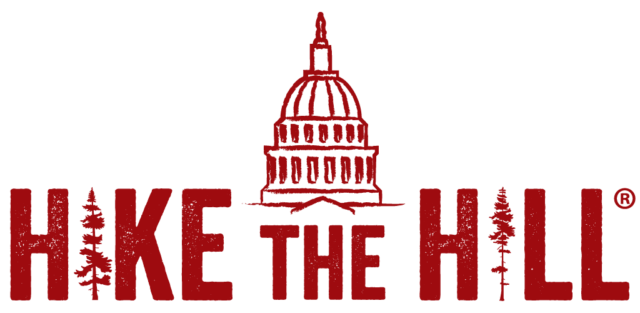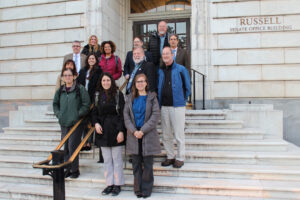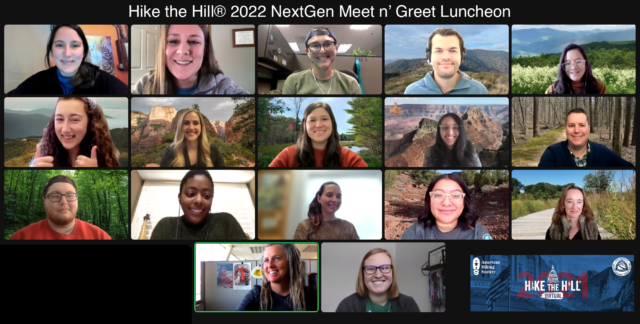Hike the Hill® is a joint effort between American Hiking Society and the Partnership for the National Trails System. It brings together the trails community to advance shared trail priorities with congressional and Federal agency leaders including trails funding, public lands management and conservation, equitable access, and other top priority issues that sustain trails and improve access to National Trails.
From February 14-18, 2022, the Partnership for the National Trails System and the American Hiking Society hosted the 25th Annual advocacy event for National Scenic & Historic Trails (NSHT): Hike the Hill®. Like the previous 24 years, the event was a national effort attended by volunteers from across the country with the shared goal of gaining support for the National Trails System (NTS).
A Grassroots Coalitional Legacy
When a coalition of 17 trail organizations (called the Committee of 17) banded together in 1991 to advocate for National Scenic & Historic Trails, they were looking toward the future of the NTS. Despite being enacted in 1968, the vision of the National Trails System Act (NTSA) had not yet been achieved, and the coalition of trail organizations saw a dire need for Federal support to ensure that it came to fruition. The NTSA envisioned “a network of trails spanning America, celebrating and cherishing our historic and scenic resources,” which would bring “recreational opportunities within easy reach of most Americans—linking them to our precious parks, forests, rivers, mountains, and historic sites” (Ridenour, 1991). Federal support—in the form of funding, assistance, resources, and organizational capacity—was needed to fully enact a trails system that achieved the NTSA’s goal of being a public good for all.
Other trail advocates proved a coalition could succeed in lobbying Congress to support trails. Advocates from the American Hiking Society (AHS) successfully lobbied for a feasibility study for the American Discovery Trail and along with the Rails-to-Trails Conservancy, succeeded in advocating for legislation that became the Intermodal Surface Transportation Efficiency Act of 1991. With these wins under their belt, the AHS helped the Committee of 17 unite to bring their agenda to Congress.
In the spring of 1992, Gary Werner, of the Ice Age Park & Trail Foundation, testified in front of the House Interior Appropriations Subcommittee on behalf of the Committee of 17. Though nothing came of it, the committee regrouped and decided they would keep going back until they got what they needed. For the next two years, Mr. Werner went to DC to advocate on behalf of the trails during events with AHS, the Sierra Club, and the Wilderness Society.
By 1995, after years of operating as the Committee of 17, the coalition of trails organizations officially adopted the Partnership for the National Trails System (PNTS) as their name. Just two years later, PNTS, now a distinct non-profit organization, joined AHS in leadership of a long-form advocacy event under the direction of Gary Werner (PNTS) and Mary Margaret Sloan (AHS). Over a week, participants learned advocacy strategies, coordinated trails messaging, and advocated for trails in meetings with Federal agency leadership, individual members of Congress, and congressional committee staff. Hike the Hill®, which brought trails advocates from across the nation to Capitol Hill for Trails Advocacy Week, was born.
Since the first Hike the Hill® 25 years ago, the trails community has earned several important victories. Significantly, the system has nearly doubled. When Hike the Hill® began, there were 17 National Scenic and Historic Trails. Today, there are 30.
Additionally, as Steve Elkinton, past program leader for the NTS in the National Park Service, said, “Hike the Hill® raised the visibility of the National Trails System in both the Federal agencies and Congress, resulting in funding increases for the trails. It built solidarity of a wide network of trail activists all across America’s political spectrum. And brought Federal agency staff and nonprofit volunteer partners closer together.” Mr. Werner says the most effective aspect of Hike the Hill® has been, “persistently going back again, and again, and again” which “meant that both on the agency side and in Congress, we institutionally developed relationships with key people in those different entities.”
The Ongoing Hike
Through consistent relationship-building with Federal agency partners and congressional members and staff, trails advocates continue the work started 25 years ago. Despite many successes, the need for trails advocacy is never gone. Mary Margaret Sloan, co-founder of Hike the Hill® and former AHS executive director points out, “There’s always a lot going on, so the challenge—then as it is now—is making the case that this is really important amongst everything else that’s happening that Congress is paying attention to.”
Hike the Hill® plays an important role in showcasing the significance and impacts of NSHT to the people who make fundamental decisions that impact trails. It is the only time when advocates from across the NSHT join in a unified effort to advance legislation, request funding, and share priorities. Through collaboration, advocates push for system-wide needs in addition to trail-specific needs, strengthening the impact of their advocacy.
Hike the Hill®: An Outline
The collaboration that makes Hike the Hill® so successful doesn’t start with the public event. Months before advocates arrive at Capitol Hill (in-person or virtually) a group of volunteers, and staff from PNTS and AHS, begin formulating trail priorities at the national level to highlight. As a collaborative effort, these priorities arise from needs shared by local advocates of the NSHT. Additionally, PNTS collects information about trail use, public engagement, volunteer hours donated, youth involvement, and advances in trail protection to help advocates demonstrate the value and positive impact of NSHT. This information is compiled into the annual State of the Trails report which serves as a ‘progress report’ for NSHT, and the ‘Gold Sheet’ which demonstrates investment in trails.
To empower the people who participate, the event begins with briefings on topics central to advocacy priorities each year, such as trails funding and appropriations, administrative priorities, new legislation, and shared messaging. Through these sessions, advocates gain a deeper understanding of national-level trails needs and how to effectively communicate trails priorities to different leaders. PNTS and AHS also provide advocacy resources for participants to use throughout the event. Then, the fun begins! Throughout Hike the Hill®, three types of meetings occur: 1) meetings with Federal partners to share information about agency work and plans, 2) meetings with Congressional committees to advocate for trails legislation and funding, and 3) meetings with individual Congressional members to showcase constituent support for trails legislation and funding. Together, these meetings establish important Federal relationships, show the considerable benefits of the National Trails System for the American public, and demonstrate widespread support for NSHT—on local and national scales.
You don’t need to be a policy expert or know how to set a meeting with your Congressional member to participate. Because of the organization, resources, and training provided through Hike the Hill®, anyone can advocate for trails. And that means more voices pushing leadership to support NSHT.
Looking Forward
The vision of a robust and accessible National Trails System has remained central to Hike the Hill®. As we reflect on the past 25 years and look toward the future, there are opportunities to build on past successes while adapting to contemporary needs.
A major adaptation of the past two years was the change to a virtual format. Despite travel restrictions caused by Covid-19, Hike the Hill® pushed forward. And, through the forced change of setting, event organizers realized the potential of virtual meetings to make advocacy more accessible to people who otherwise would not be able to participate.
Building on the collaboration that has always been central to Hike the Hill® will include making trails advocacy accessible to new groups of people. Kate Van Waes, current AHS executive director encouraged, “bring[ing] more voices to the table . . . Bringing in other groups that traditionally haven’t been involved and broadening the conversation.” Encouraging new collaborators to participate in trails advocacy can help, as Senior Director for Programs and Advocacy of AHS Tyler Ray envisions, “continue to grow and expand participation in Hike the Hill® while staying true to the event’s purpose of bringing together the voices of the trails community as a whole and the National Trails System.”
Because advocacy is never done, more voices and more accessible ways to advocate throughout the year will be important moving forward. Valerie Rupp, executive director of PNTS states: “Moving forward, I’m excited for PNTS, AHS, PNTS member organizations, and other trails and outdoor recreation advocates to build on the success of Hike the Hill® to come together more frequently throughout the year – making Hike the Hill a key touchpoint in a continuum of cooperative action. While the ‘fly-in’ aspect may only be feasible for people on an annual basis, we’ve learned to hold effective meetings virtually, making it easier to continue the conversations as a larger group of partners on an ongoing basis while also increasing accessibility to interested stakeholders who have not been a part of our advocacy work in the past.”
Learn more about Hike the Hill® on our website: pnts.org/new/our-work/hike-the-hill
Access reports and case studies used to demonstrate the impact of trails on our website: pnts.org/new/our-work/reports/



